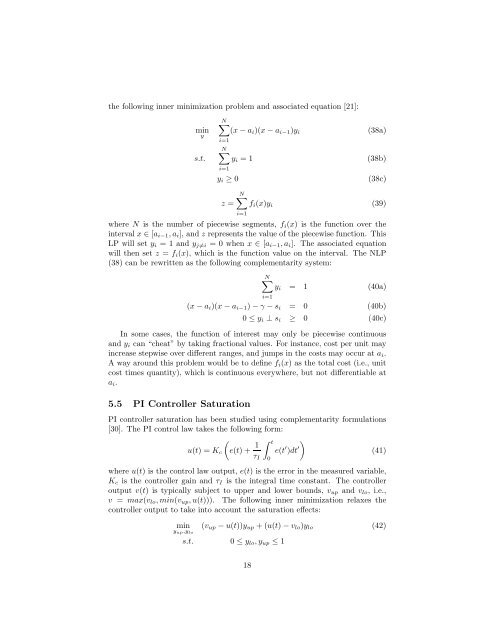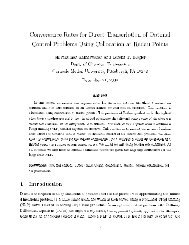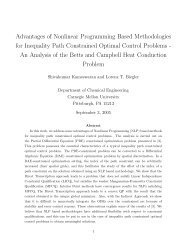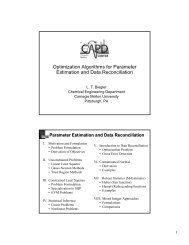MPEC Problem Formulations in Chemical Engineering Applications
MPEC Problem Formulations in Chemical Engineering Applications
MPEC Problem Formulations in Chemical Engineering Applications
You also want an ePaper? Increase the reach of your titles
YUMPU automatically turns print PDFs into web optimized ePapers that Google loves.
the follow<strong>in</strong>g <strong>in</strong>ner m<strong>in</strong>imization problem and associated equation [21]:m<strong>in</strong>ys.t.N ∑i=1(x − a i )(x − a i−1 )y i (38a)N∑y i = 1i=1y i ≥ 0(38b)(38c)z =N∑f i (x)y i (39)i=1where N is the number of piecewise segments, f i (x) is the function over the<strong>in</strong>terval x ∈ [a i−1 , a i ], and z represents the value of the piecewise function. ThisLP will set y i = 1 and y j≠i = 0 when x ∈ [a i−1 , a i ]. The associated equationwill then set z = f i (x), which is the function value on the <strong>in</strong>terval. The NLP(38) can be rewritten as the follow<strong>in</strong>g complementarity system:N∑y i = 1 (40a)i=1(x − a i )(x − a i−1 ) − γ − s i = 0 (40b)0 ≤ y i ⊥ s i ≥ 0 (40c)In some cases, the function of <strong>in</strong>terest may only be piecewise cont<strong>in</strong>uousand y i can “cheat” by tak<strong>in</strong>g fractional values. For <strong>in</strong>stance, cost per unit may<strong>in</strong>crease stepwise over different ranges, and jumps <strong>in</strong> the costs may occur at a i .A way around this problem would be to def<strong>in</strong>e f i (x) as the total cost (i.e., unitcost times quantity), which is cont<strong>in</strong>uous everywhere, but not differentiable ata i .5.5 PI Controller SaturationPI controller saturation has been studied us<strong>in</strong>g complementarity formulations[30]. The PI control law takes the follow<strong>in</strong>g form:(u(t) = K c e(t) + 1 ∫ t)e(t ′ )dt ′ (41)τ Iwhere u(t) is the control law output, e(t) is the error <strong>in</strong> the measured variable,K c is the controller ga<strong>in</strong> and τ I is the <strong>in</strong>tegral time constant. The controlleroutput v(t) is typically subject to upper and lower bounds, v up and v lo , i.e.,v = max(v lo , m<strong>in</strong>(v up , u(t))). The follow<strong>in</strong>g <strong>in</strong>ner m<strong>in</strong>imization relaxes thecontroller output to take <strong>in</strong>to account the saturation effects:0m<strong>in</strong>y up,y lo(v up − u(t))y up + (u(t) − v lo )y lo (42)s.t. 0 ≤ y lo , y up ≤ 118






